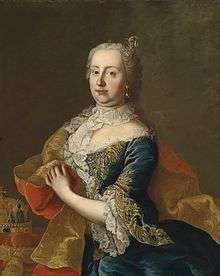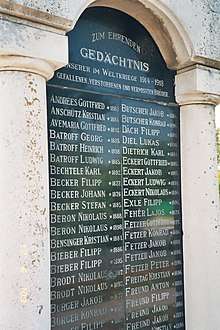Danube Swabians
The Danube Swabians (German: ![]()
Donauschwaben | |
|---|---|
| Total population | |
| 230,509 | |
| Regions with significant populations | |
| 186,596[1] | |
| 36,884[2] | |
| 4,064[3] | |
| 2,965[4] | |
| Languages | |
| Hungarian, Romanian, Serbian, Croatian, German | |
| Religion | |
| Roman Catholicism, Lutheran | |
| Related ethnic groups | |
| Germans of Hungary, Germans of Romania, Germans of Serbia, Germans of Croatia, Banat Swabians, Satu Mare Swabians | |
The Danube Swabians are considered the most recent group of ethnic German people to emerge in Europe.[5] In the 21st century, they are made up of ethnic Germans from many former and present-day countries: Germans of Hungary; Satu Mare Swabians; the Banat Swabians; and the Vojvodina Germans of Serbia's Vojvodina and Croatia's Slavonia, especially those in the Osijek region. They called themselves Schwowe in a Germanized spelling, or "Shvoveh" in an English spelling; in the singular first person, a Danube Swabian identified as a Schwob or a Shwobe.
In Serbo-Croatian, Danube Swabians, alongside the local populace would refer to them as Švabo, or Njemci, referring to their ethnic origin. However, the Carpathian Germans and Transylvanian Saxons are not included within the Danube Swabian group.
After the collapse of the Austro-Hungarian Empire following the First World War, the settlement areas of the Danube Swabians were divided into three parts by the Allied Powers. One part remained with Hungary, the second part was allocated to Romania, and the third part fell to the newly established state of Yugoslavia. In this atmosphere of ethnic nationalism, the Danube Swabians had to fight for legal equality as citizens and for the preservation of their cultural traditions. In the 1930s, Nazi Germany promoted National Socialist ideas to the Danube Swabians and claimed the right to protect them as part of its reason for expanding into eastern Europe.[6]
The Danube Swabians faced particular challenges in the Second World War, when the Axis powers, including Germany, overran many of the nations where they lived. While they were initially favored by the occupiers, some were moved from their homes. As the war progressed and Germany needed more soldiers, the men were conscripted. Many atrocities took place during and after the war, as a result of the complicated allegiances and the brutality of the Nazis.
Toward the end of the Second World War, tens of thousands of Danube Swabians fled west ahead of the advancing Soviet army. After the war, the remaining Danube Swabians were disenfranchised, their property seized, and many were deported to labor camps in the Soviet Union. Hungary expelled half of its ethnic Germans.[7] In Yugoslavia, the local "ethnic Germans" were collectively blamed for the actions of Nazi Germany and branded as war criminals. Immediately after the end of the war, partisan troops conducted mass executions of numerous Yugoslav Danube Swabians. Survivors were later confined to labor and internment camps by the Yugoslavian authorities.[8] Following the dissolution of the camps, the majority of the remaining Yugoslav Danube Swabians left the country, seeking refuge in Germany, other parts of Europe, and the United States.
Of the 1.4 to 1.5 million pre-war population of Danube Swabians, the overwhelming majority of the survivors resettled in German-speaking countries: about 660,000 in Germany and about 150,000 in Austria. Danube Swabians also resettled in the United States, Canada, Brazil, Argentina, and Australia.[9] The diaspora communities of Danube Swabians maintain their language and customs in numerous societies and clubs. The number of organizations is shrinking as the generations that lived in the Danube Swabian homelands die.
Moreover, due to the waning population of Danube Swabians within the Balkans, the word Švabo now refers to the ex-Yugoslavian diaspora communities that live/work as gästarbeiters in German-speaking countries, such as Germany, Austria, or Switzerland, and sometimes the Netherlands, Belgium, or Luxembourg. In a negative context, the term is confided with the English equivalent to a rich kid/spoiled brat, due to the unprecedented wealth that is gained by one family in said countries that their relatives that still live in the ex-Yugoslavia region often struggle to obtain, due to the high unemployment rates in their respective countries.
History
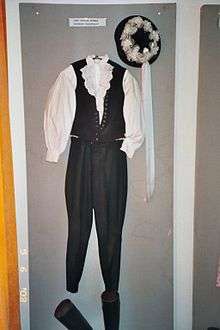
Origins
Beginning in the 12th century, German merchants and miners began to settle in the Kingdom of Hungary at the invitation of the Hungarian monarchy (see Ostsiedlung). Although there were significant colonies of Carpathian Germans in the Spiš mountains and Transylvanian Saxons in Transylvania, German settlement throughout the rest of the kingdom had not been extensive until this time.
During the 17th–18th centuries, warfare between the Habsburg Monarchy and the Ottoman Empire devastated and depopulated much of the lands of the Danube valley, referred to geographically as the Pannonian plain. The Habsburgs ruling Austria and Hungary at the time resettled the land with people of various ethnicities recruited from the Austro-Hungarian Empire of the Habsburgs, including Magyars, Czechs, Slovaks, Croats, Serbs, Romanians, Ukrainians, and Germanic settlers from Swabia, Hesse, Palatinate, Baden, Franconia, Bavaria, Austria, and Alsace-Lorraine. Despite differing origins, the new immigrants were all referred to as Swabians by their neighbor Serbs, Hungarians, and Romanians. The Bačka settlers called themselves Schwoweh, the plural of Schwobe in the polyglot language that evolved there. The majority of them boarded boats in Ulm, Swabia, and traveled to their new destinations down the Danube River in boats called Ulmer Schachteln. The Austro-Hungarian Empire had given them funds to build their boats for transport.
Settlement
The first wave of resettlement came after the Ottoman Turks were gradually being forced back after their defeat at the Battle of Vienna in 1683. The settlement was encouraged by nobility, whose lands had been devastated through warfare, and by military officers including Prince Eugene of Savoy and Claudius Mercy. Many Germans settled in the Bakony (Bakonywald) and Vértes (Schildgebirge) mountains north and west of Lake Balaton (Plattensee), as well as around the town Buda (Ofen), now part of Budapest. The area of heaviest German colonization during this period was in the Swabian Turkey (Schwäbische Türkei), a triangular region between the Danube River, Lake Balaton, and the Drava (Drau) River. Other areas settled during this time by Germans were Pécs (Fünfkirchen), Satu Mare (Sathmar), and south of Mukachevo (Munkatsch).
After the Habsburgs annexed the Banat area from the Ottomans in the Treaty of Passarowitz (1718), the government made plans to resettle the region to restore farming. It became known as the Banat of Temesvár (Temeschwar/Temeschburg), as well as the Bačka (Batschka) region between the Danube and Tisza (Theiss) rivers. Fledgling settlements were destroyed during another Austrian-Turkish war (1737–1739), but extensive colonization continued after the suspension of hostilities.
The late 18th-century resettlement was accomplished through private and state initiatives. After Maria Theresa of Austria assumed the throne as Queen of Hungary in 1740, she encouraged vigorous colonization on crown lands, especially between Timișoara and the Tisza. The Crown agreed to permit the Germans to retain their language and religion (generally Roman Catholic). The German farmers steadily redeveloped the land: drained marshes near the Danube and the Tisza, rebuilt farms, and constructed roads and canals. Many Danube Swabians served on Austria's Military Frontier (Militärgrenze) against the Ottomans. Between 1740 and 1790, more than 100,000 Germans immigrated to the Kingdom of Hungary.
The Napoleonic Wars ended the large-scale movement of Germans to the Hungarian lands, although the colonial population increased steadily and was self-sustaining through natural increase. Small daughter-colonies developed in Slavonia and Bosnia. After the creation of Austria-Hungary in 1867, Hungary established a policy of Magyarization whereby minorities, including the Danube Swabians, were induced by political and economic means to adopt the Magyar language and culture.
Beginning in 1893, Banat Swabians began to move to Bulgaria, where they settled in the village of Bardarski Geran, Vratsa Province, founded by Banat Bulgarians several years prior to that. Their number later exceeded 90 families. They built a separate Roman Catholic church in 1929 due to conflicts with the Bulgarian Catholics. Some of these Germans later moved to Tsarev Brod, Shumen Province, together with a handful of Banat Bulgarian families, as well as to another Banat Bulgarian village, Gostilya, Pleven Province.
After the treaties of Saint-Germain (1919) and Trianon (1920) following World War I, the Banat was divided between Romania, Yugoslavia, and Hungary; Bačka was divided between Yugoslavia and Hungary; and Satu Mare went to Romania. Before World War II, the biggest populations of Germans in the Vojvodina were at Hodschag, Werbass, and Apatin.
There were approximately two million ethnic Danube Swabians in the region before World War II. In Romania, census of 1930 recorded 745,421 Germans; Hungarian Census of 1933 recorded 477,153; and Yugoslavian Census of 1921, 513,472. German estimations from the interwar period place those estimations at 850,000; 600,000 and 620,000 for Romania, Hungary and Yugoslavia respectively.[10]
World War II, expulsion, and post-war
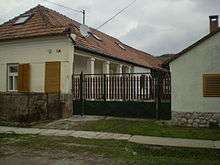
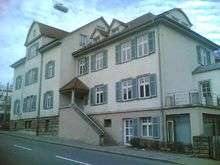
Beginning in 1920 and especially after World War II, many Danube Swabians migrated to the United States, Brazil, Canada, Mexico, Austria, Australia, and Argentina. Some of them, descending from French-speaking or linguistically mixed families from Lorraine, had maintained the French language for some generations, as well as an ethnic identity, later referred to as Banat French, Français du Banat. They were resettled in France around 1950.[11]
In 1941 much of Yugoslavia was invaded and occupied by Nazi Germany as part of the Second World War, and in the German-occupied Banat, they granted the Swabian minority superior status over the other ethnic groups in the Yugoslav population. The Baranja and Bačka Swabians reverted to Hungary.[12] The Danube Swabians were already under heavy Nazi influence by that time and served as the Axis fifth column during the invasion of Yugoslavia, although many served in the royal Yugoslav army in the brief war against the Nazis in April 1941.[13] The Independent State of Croatia (1941–1945), a fascist puppet state[14][15] created within Axis-occupied Yugoslavia, was home to 182,000 Danube Swabian ethnic Germans (who were called Folksdojčeri in Croatian).[16] In addition, the Danube Swabian minority were granted the separate autonomous region of Banat within German-occupied Serbia[17] In Backe in 1941, Danube Swabians formed around 20% of the population.[18] Yugoslav Danube Swabians supplied more than 60,000 troops for German military formations, some voluntarily but many more under duress. They actively participated in the sometimes brutal repression of Yugoslav Partisans and their suspected sympathizers, including 69,000 Jews living in Yugoslavia.[13]
The local collaborationist authorities were forced to make it illegal to draft Danube Swabians. However, of the approximately 300,000-strong Danube Swabian minority in occupied Yugoslavia (182,000 in the NDH, 350,000 in Vojvodina), 500,000 in Romania and 500,000 in Hungary, approximately 100,000 eventually entered service in various German and Axis military organizations, most notably in the two locally formed Waffen-SS volunteer divisions, the 7th SS Volunteer Mountain Division Prinz Eugen, and the 22nd SS Volunteer Cavalry Division Maria Theresa (which was made-up of Hungarian Danube Swabians).
Although these military units were initially formed as volunteer units,[13] SS officials ultimately imposed conscription under the dubious legal pretext that occupied Serbia was deutsches Hoheitsgebiet, and the archaic Tiroler Landsturmordung (Tyrol General Levy Act) of 1872 was invoked.[19] The 7th SS Prinz Eugen was formed as a volunteer unit, but historians have demonstrated that later in the war, the local German authorities of Banat came under significant pressure from the German authorities. Essentially, coercion was used to recruit more troops. Guenther Reinecke, chief of the Hauptamt SS-Gericht (SS legal office) wrote to Himmler that the Prinz Eugen was "no longer an organization of volunteers, that on the contrary, the ethnic Germans from Serbian Banat were drafted, to a large extent under threat of punishment by the local German leadership, and later by the SS Ergänzungsamt."[20] Of about 100,000 Danube Swabians who served in the various SS units, approximately 29,000 were killed. This total includes 2,000 POWs from the 7th SS Prinz Eugen who were summarily executed by the Allied Yugoslav troops as Yugoslav citizens collaborating with the enemy.
Between 1941 and 1943, a total of 2,150 ethnic German Bulgarian citizens were transferred to Germany as part of Adolf Hitler's Heim ins Reich policy. These included 164 Banat Swabians from Bardarski Geran and 33 from Gostilya.[21]
In 1944, a joint advance of the Yugoslav Partisans, and the Soviet Red Army saw the liberation of northern areas of German-occupied Yugoslavia, which were home to the Danube Swabian minority. In Yugoslavia in particular, with many exceptions, the Danube Swabian minority "collaborated . . . with the occupation".[13] Consequently, on November 21, 1944 the Presidium of the AVNOJ (the Yugoslav parliament) declared the ethnic German minority in Yugoslavia collectively hostile to the Yugoslav state.[22] The AVNOJ Presidium issued a decree that ordered the government confiscation of all property of Nazi Germany and its citizens in Yugoslavia, persons of ethnic German nationality (regardless of citizenship), and collaborators. The decision acquired the force of law on February 6, 1945.[23] The reasons for this announcement are still debated by historians, but revenge against the ethnic German minority and the expropriation of Swabian agricultural lands to facilitate collectivization in Yugoslavia appears to have been the prime reasons.[24]
During the Second World War, many ethnic Germans sent the youngest and the oldest of their families to Germany. From 1945–48, many ethnic Germans in Hungary were dispossessed and expelled to Allied-occupied Germany under the Potsdam agreement. In the Bačka, which had been part of Hungary from 1941, Schwowisch villages were emptied forcibly in March 1945. The old and the young were imprisoned in camps in several villages of Vojvodina (in modern Serbia) including Gakovo, Kruševlje, Rudolfsgnad (Knićanin), Molidorf (Molin), Bački Jarak, and Sremska Mitrovica, and two villages in the Slavonia region of Yugoslavia (now part of Croatia), Krndija, Valpovo.[24] Those able to work were used as slave labor throughout the countryside. On March 1, 1946 there was a proposal to expel 130,388 interned Yugoslav ethnic Germans under the Potsdam Agreement.[25] This proposal was turned down but provides a good estimate of the number of Shwovish internees. Many thousands were forcibly removed by cattle cars to Russia as Allied "war reparations", being put to work as slave labor in Siberian coal mines and elsewhere until 1949, when the program was shut down. The conditions were poor, and about half of those sent to Russia died from malnutrition or disease.
In Yugoslavia in 1945, most ethnic Germans had their land confiscated and some were stripped of their citizenship by the new communist government. They faced summary executions, massacres, deportations. They were rounded up en masse, and some were sent to concentration and labor camps, where they died in considerable numbers. About 27,000 – 37,000 women aged 18–40 were sent to the Soviet Union to perform forced labor. In addition, 35,000–40,000 Swabian children under age sixteen were separated from their parents and force into prison camps and re-education orphanages. Many were adopted by Serbian Partisan families.[26]
Of a pre-war population of about 350,000 ethnic Germans in the Vojvodina, the 1958 census revealed 32,000 left. Officially, Yugoslavia denied the forcible starvation and killing of their Schwowisch populations, but reconstruction of the death camps reveals that of the 170,000 Danube Swabians interned from 1944 to 1948, about 50,000 died of mistreatment.[24] Since only families with the very young (under three), very old, and mothers were interned and starved, many others were unaccounted for in slave labor settings throughout the countryside and in Russia; but their death rates were probably much lower. The Germans in Romania were not deported but were instead dispersed within Romania. Austrian historian Arnold Suppan considers the destruction of the Danube Swabians to be genocide.[27]
Since 1990
Many left Romania for West Germany between 1970–90, and this trend increased in 1990. Since the fall of communism and the formation of new nations with new borders, the forces for movement of people among European nations have changed. Hungary joined the European Union and travel between nations became simpler. From 2001 to 2011, the number of those identifying as German in Hungary increased sharply, comparing the census tables from the two years. Explanations for the increase seem complex, including the willingness of citizens to claim the ethnic identity.
Culture

Prior to the First World War, the Swabians were the largest ethnic group to assimilate into Hungarian society, seconded by the Galician Jews and the Slovaks. They were first and foremost Catholics, peasants thereafter, and thirdly loyal subjects to Kaiser Franz Joseph. But a distinct Hungarian Swabian ethno-national consciousness didn't develop until the spread of Romantic Nationalism in the late nineteenth century.
For the greater portion of their history, the Danube Swabian did not share a cultural identity. The term Swabian has its roots in the first wave a German-speaking immigrants from Swabia to re-settle southern Hungary after the expulsion of the Ottomans in 1689. However, it came to encompass all German-speaking people who followed in migrations from across the Holy Roman Empire in the eighteenth and nineteenth century. The term Swabian was not originally a self-proclaimed identity of a singular people but a term ascrided by Magyar lords to refer to German-speaking Catholic peasants, tavern keepers, and poor artisans. For the most part Swabians lived in villages, had few privileges, and no developed intellectual layer.[28] In 1930 Hungary 55.4% of the total Swabian population were engaged in agriculture; 28.8% in industry, crafts, commerce, or transport; and 3.1% were in state administration. The rest were employed in the service sector.[29]
The Danube Swabian culture is a melting pot of southern German regional customs, with a large degree of Balkan and mostly Hungarian influence. This is especially true of the food, where paprika is heavily employed, which led to the German nickname for Danube Swabians as Paprikadeutsche. The architecture is neither Southern German nor Balkan but is unique to itself. The houses, often made of stamped mud and straw walls or mud bricks, are ubiquitous throughout the Vojvodina region. Georg Weifert was responsible for developing one of the most famous beers in the Serbia/Yugoslavia region and later became an important banker and politician in Belgrade (his image currently features on the Serbian 1000 dinar note).

Language
The Danube Swabian language is only nominally Swabian (Schwowisch, as it was referred to locally). In reality, it contains elements or many dialects of the original German settlers, mainly Swabian, Franconian, Bavarian, Pfälzisch, Alsatian, and Alemannic, as well as Austro-Hungarian administrative and military jargon. Loanwords from Hungarian, Serbian, or Romanian are especially common regionally regarding cuisine and agriculture, but also regarding dress, politics, place names, and sports. Other cultures of influence include Serbian and Croatian, Russian (for communist concepts), Romanian, Turkish (Hambar), English (for football), and general Balkan and South Slavic loanwords like Kukuruts (corn). The plural of loanwords is in most cases formed in the Shwovish way. Conjunctions and adverbs from the respective contact languages may be integrated as well.[30]
Many German words used by speakers of Danube Swabian dialects may sound archaic. To the ear of a Standard German speaker, the Danube Swabian dialect sounds like what it is: a mix of southwestern German dialects from the 18th century with many strange words from other languages. Due to relative isolation and differing proximities to nearby German speakers (Austrians and Transylvanian Saxons), the language varies considerably, with speakers able to distinguish inhabitants of neighboring villages by the words they use for such things as marmalade (Leckwaar and Schleckle being two variants), or by how many (usually Hungarian) loanwords they employ.This even applied to verb conjugations. For example, the German verb "haben" was conjugated as "han" in Sankt Hubert and as "hava" In Mramorak, although both were in Banat.[31] Herman Ruediger, a German sociologist, reports that in his trips throughout the Bačka in the 1920s, he noted that Danube Swabians from widely separated villages had to use standard high German to communicate with each other because their speech was so different. This was particularly true for towns like Esseg (Osijek) where Shwoveh were thoroughly with majority Croatians.[32] For instance, the ethnic Germans of Esseg were so thoroughly assimilated with Croatia that their Shwovish or 'Essekerish' could only be understood by those who also spoke Croatian or Serbian.
Naming
As is the custom in Hungary (as well as southern Germany), Danube Swabians often put the surname first, especially when writing, for example Butscher Jakob (see photo of memorial). Danube Swabian villages tend to have relatively few family names as the villagers stem from only a few families, but usually the same family name does not appear in more than a couple of villages, meaning that there are many Danube Swabian family names. The names come from throughout southern Germany, from assimilated Hungarians, and occasionally from Balkan and Italian origins. There are usually no middle names, but often double first names, if a distinction can be made. The variety of first names is few, since children were usually named after grandparents or godparents. Popular names for women include: Anna, Barbara, Christina, Elisabeth, Eva, Katharina, Magdalena, Maria, Sophia, Theresia, and many two-name combinations thereof. Popular names for men include: Adam, Anton, Christian, Franz, Friedrich, Georg, Gottfried, Heinrich, Jakob, Johann, Konrad, Ludwig, Mathias, Martin, Michael, Nikolaus, Peter, Philipp (or Filipp), and Stefan (or Stephan). With so few names in villages, other modifiers or nicknames were almost always used to distinguish people. The modifiers were often size related (e.g., "Kleinjohann" or "Little Johann"), occupation related ("Tischler Stefan" or the "carpenter Stefan"), or location related (usually by prefixing the streetname).
Coat of arms
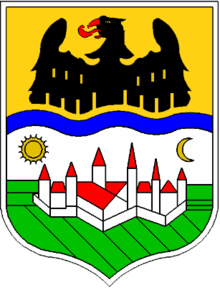
A coat of arms designed in 1950 by Hans Diplich has been adopted by many Danube Swabian cultural organizations. Its blazon is "Parti per fess wavy 1 Or, an eagle displayed couped Sable langued Gules; 2 parti per fess Argent and Vert, a fortress Argent roofed and turreted Gules surmounted with Sun and Crescent waning Or; chief wavy Azure".
It depicts:
- a black eagle representing the protection of the Emperor of Austria;
- a blue ribbon representing the Danube River;
- a crescent moon representing the waning of Islamic influence through the withdrawal of the Ottoman Turks;
- the Sun representing both Prince Eugene of Savoy and the light of Christianity; and
- a fortress representing the fortified city of Temeschburg (Timișoara).
Resources for genealogical research
Germany
- Institut für Auslandsbeziehungen Stuttgart; (institute of foreign relations); church records (microfilm) of villages in the banat
Austria
- Theresianischer Kataster, Österreichisches Staatsarchiv, Finanz- und Hofkammerarchiv; Austrian archive
Luxembourg
- Institut Grand-Ducal, Section de Linguistique, d’Ethnologie et d’Onomastique, village chronics and family records
- Centre de Documentation sur les Migrations Humaines
- Nationalarchiv Luxemburg, Microfilms, notary records, church records
See also
- Expulsion of Germans after World War II
- Germans of Hungary#Expulsion
- Wehrbauer
- Banat Swabians
- Ethnic German
- Volksdeutsche
- Carpathian Germans
- Baltic Germans
- Transylvanian Saxons
- Volga Germans
- Georg Weifert
- German World Alliance
References
- 2.7 Német 2.7.1 A népesség korcsoport, településtípus és nemek szerint, a nemek aránya, 2011, Összesen [2.7 German 2.7.1 Population by age group, type of settlement and gender, sex ratio, 2011, Total] (PDF). 2011. ÉVI NÉPSZÁMLÁLÁS 9. Nemzetiségi adatok (in Hungarian). Budapest. 2014. p. 94. ISBN 978-963-235-355-5. Retrieved May 22, 2017.
- Tabelul 2. Populaţia stabilă după etnie, pe judeţe [Table 2. Stable population by ethnicity by counties] (PDF). privind rezultatele provizorii ale Recensământului Populaţieişi Locuinţelor – 2011(provisional results of Population and Housing Census – 2011) (in Romanian). February 2, 2012. p. 10.
- Table A1: Population by ethnicity, as per the 1948–2011 censuses (PDF). Ethnicity in the 2011 Census of Population, Households and Dwellings in the Republic of Serbia. 2012. p. 14. ISBN 978-86-6161-023-3. Retrieved May 18, 2017.
- "Stanovništvo prema narodnosti, popisi 1971. – 2011" (in Croatian). Retrieved December 21, 2012.
- Senz, Josef Volkmar (1987). Geschichte der Donau-Schaeben: Von den Anfängen bis zur Gegenwart. Munich: Amalthea. p. dust jacket.
- gbv.de, Gemeinsamer Bibliotheksverbund, Frankfurter Allgemeine Zeitung, Johannes Hürther: Rezension: Casagrande, Thomas: Die volksdeutsche SS-Division „Prinz Eugen“ – Die Banater Schwaben und die nationalsozialistischen Kriegsverbrechen. ISBN 3-593-37234-7, 18. Dezember 2003, S. 8
- Mathias Beer: Flucht und Vertreibung der Deutschen. Voraussetzungen, Verlauf, Folgen. München, 2011, ISBN 978-3-406-61406-4, S. 205, hier S. 91.
- Zoran Janjetović, Die Konflikte zwischen Serben und Donauschwaben, S. 162 In „Der Einfluss von Nationalsozialismus auf Minderheiten in Ostmittel- und Südeuropa“, Published by Mariana Hausleitner and Harald Roth, IKS Verlag, Munich, 2006 (Wissenschaftliche Reihe „Geschichte und Zeitgeschichte“ der Ludwig-Maximilians-Universität Munich, Volume 107: Published by Edgar Hösch, Thomas Krefeld und Anton Schwob)
- Gehl, Hans. Wörterbuch der donauschwäbischen Lebensformen [Dictionary of the Danube Swabian Way of Life].
- Paikert, G.C. (December 6, 2012). The Danube Swabians: German Populations in Hungary, Rumania and Yugoslavia, and Hitler's impact on their Patterns. Springer Science & Business Media. p. 3. ISBN 978-94-011-9717-5.
- Vultur, Smaranda (2001). De l’Ouest à l’Est et de l’Est à l’Ouest : les avatars identitaires des Français du Banat [From West to East and From East to West: the identity avatars of the French of Banat]. la conférence d'histoire orale "Visibles mais pas nombreuses : les circulations migratoires roumaines" (in French). Paris. Retrieved May 18, 2017.
- Tomasevich 1975.
- Tomasevich, Jozo (2001). War and Revolution in Yugoslavia, 1941–1945: Occupation and Collaboration. 2. Stanford University Press. ISBN 978-0-8047-3615-2.
- Independent State of Croatia – Britannica Online Encyclopedia
- "Axis Invasion of Yugoslavia". Holocaust Encyclopedia. United States Holocaust Memorial Museum. Retrieved May 18, 2017.
- Pavlowitch, Stevan K. (2008). Hitler's New Disorder. Columbia University Press. ISBN 9780231700504.
- Böhm, Johann (2012). Die deutschen Volksgruppen im Unabhängigen Staat Kroatien und im serbischen Banat. Ihr Verhältnis zum Dritten Reich 1941–1944 [The German Peoples in the Independent State of Croatia and the Serbian Banat. Their relationship to the Third Reich 1941–1944] (in German). Frankfurt am Main: Peter Lang, Internationaler Verlag der Wissenschaften. ISBN 978-3631633236.
- Ravlic, Aleksander, ed. (1998). "Ethnic Structure of the Population of Backe for the Period 1910–1991". An International Symposium: Southeastern Europe 1918 to 1995 (in Bosnian). Croatian Heritage Foundation and Croatian Information Center. ISBN 978-953-6525-05-8. Retrieved May 18, 2017.
- Stein, George H. (1966). The Waffen-SS, Hitler's Elite Guard at War 1939–1945. Cornell University Press. p. 172. ISBN 978-0801492754.
- Stein, George H. (1966). The Waffen-SS, Hitler's Elite Guard at War 1939–1945. Cornell University Press. p. 171.
- Njagulov, Blagovest (1999). "Banatskite bǎlgari v Bǎlgarija". Banatskite bǎlgari: istorijata na edna malcinstvena obštnost vǎv vremeto na nacionalnite dǎržavi (in Bulgarian). Sofia: Paradigma. ISBN 978-954-9536-13-3.
- Ramet 2006, p. 159.
- Tomasevich 1969, p. 115, 337.
- Janjetović, Zoran (2005). Between Hitler and Tito. The Disappearance of the Vojvodina Germans (2nd ed.). Belgrade: Selbstverl. ISBN 978-8690681105.
- Lt.-Gen. Avsich, Yugoslav Military Mission, Berlin to the Allied Control Commission. Foreign Office 1032/2284.
- Black, Monica (Spring–Summer 2013). "Expellees Tell Tales: Partisan Blood Drinkers and the Cultural History of Violence after World War II". History and Memory. 25 (1): 77–110.
- Suppan, Arnold (2019). Hitler–Beneš–Tito: National Conflicts, World Wars, Genocides, Expulsions, and Divided Remembrance in East-Central and Southeastern Europe, 1848–2018. Vienna: Austrian Academy of Sciences Press. p. 743. ISBN 978-3-7001-8410-2. JSTOR j.ctvvh867x.
- Szelényi, Balázs A. (August 2007). "From Minority to Übermensch: The Social Roots of Ethnic Conflict in the German Diaspora of Hungary, Romania and Slovakia". Past & Present. No. 196: 215–251.
- Kovacs, Alajos (1936). "The Statistical Situation of the Germans in the Trianon Treaty Reduced Territories of Hungary". Budapest.
- Bentz, Michaela (2008). Kokkonidis, Miltiadis (ed.). German as a Minority Language: The "Swabians" in the Danubian States and their Language(s) (PDF). Proceedings of LingO 2007. University of Oxford. pp. 20–26.
- Hess, Michael, personal experience with native speakers from each town
- Ruediger, H. (1931) Die Donauschwaben in der südslawischen Bačka, Schriften des Deutschen Ausland-Instituts Stuttgart. Reihe A. Bd. 28. Stuttgart, 1931
Further reading
- G.C. Paikert (2012). The Danube Swabians: German Populations in Hungary, Rumania and Yugoslavia, and Hitler's impact on their Patterns. Springer Science & Business Media. ISBN 978-94-011-9717-5.
- Valentina Glajar (2004). The German Legacy in East Central Europe as Recorded in Recent German-language Literature. Camden House. ISBN 978-1-57113-256-7.
- Ulrich Merten (2017). Forgotten Voices: The Expulsion of the Germans from Eastern Europe After World War II. Taylor & Francis. ISBN 978-1-351-51954-0.
- Katherine Stenger Frey (1982). The Danube Swabians: A People with Portable Roots. Mika Publishing Company. ISBN 978-0-919303-61-4.
- Bresser, M., 1983. The Danube Swabians: Biography of a People from Inception to Dispersal. Danube Swabian Association.
- Wieden, F. and Benzinger, M., 1992. Canada's Danube Swabians. St. Michael's Church.
- Hubbard, K. J. (2013). "The Danube Swabians: A Post-war Extermination" (PDF). Cite journal requires
|journal=(help) - Glajar, V., 1997. Banat-Swabian, Romanian, and German: Conflicting Identities in Herta Müller's" Herztier". Monatshefte, pp. 521–540.
- Krallert, Wilfried (1958). Atlas zur Geschichte der deutschen Ostsiedlung. Bielefeld: Velhagen & Klasing.
- Valdis O. Lumans, Himmler's Auxiliaries: The Volksdeutsche Mittelstelle and the German National minorities of Europe, 1939–1945 (University of North Carolina Press, 1993), page 235.
External links
| Wikimedia Commons has media related to Danube Swabians. |
